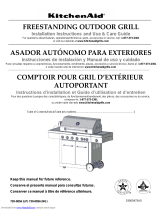
2
T
ABLE OF CONTENTS
OUTDOOR GRILL SAFETY.................................................................3
INSTALLATION REQUIREMENTS.................................................... 5
Tools and Parts ........................................................................................ 5
Location Requirements............................................................................ 5
Product Dimensions................................................................................. 6
Built-In Outdoor Grill Enclosure ............................................................ 6
Cabinet Cutout Dimensions .................................................................... 7
Gas Supply Requirements ....................................................................... 8
Gas Connection Requirements................................................................9
REPLACEMENT PARTS .....................................................................10
INSTALLATION INSTRUCTIONS....................................................12
Unpack Grill ..........................................................................................12
Install Grill............................................................................................. 12
Make Gas Connection ...........................................................................14
GAS CONVERSIONS ............................................................................ 15
Check and Adjust the Burners...............................................................18
OUTDOOR GRILL USE....................................................................... 20
Using Your Outdoor Grill..................................................................... 20
Using Your Infrared Searing Burner
.................................................... 22
Using Your Rotisserie Burner............................................................... 22
Rotisserie Cooking Tips........................................................................ 23
TIPS FOR OUTDOOR GRILLING..................................................... 24
Cooking Methods.................................................................................. 24
Grilling Chart ........................................................................................ 25
OUTDOOR GRILL CARE ................................................................... 27
Replacing the Igniter Battery................................................................ 27
General Cleaning................................................................................... 27
TROUBLESHOOTING......................................................................... 29
ASSISTANCE.......................................................................................... 29
Accessories............................................................................................ 29
WARRANTY........................................................................................... 30
ÍNDICE
SEGURIDAD DEL ASADOR PARA EXTERIORES....................... 33
REQUISITOS DE INSTALACIóN......................................................35
Herramientas y piezas............................................................................35
Requisitos de ubicación......................................................................... 35
Medidas del producto ............................................................................36
Recinto del asador empotrado para exteriores
......................................36
Dimensiones del corte del armario........................................................37
Requisitos del suministro de gas........................................................... 38
Requisitos para la conexión de gas ....................................................... 39
PIEZAS DE REPUESTO ....................................................................... 41
INSTRUCCIONES DE INSTALACIóN.............................................44
Desempaque el asador........................................................................... 44
Instalación del asador ............................................................................ 45
Conexión del suministro de gas ............................................................45
CONVERSIONES DE GAS................................................................... 46
Revise y regule los quemadores............................................................50
USO DEL ASADOR PARA EXTERIORES....................................... 52
Cómo usar el asador para exteriores..................................................... 52
Uso del quemador infrarrojo para dorado rápido ................................. 54
Uso del quemador del rostizador .......................................................... 54
Consejos para la cocción con el rostizador........................................... 55
CONSEJOS PARA ASAR AL AIRE LIBRE...................................... 56
Métodos de cocción............................................................................... 57
Cuadro para asar.................................................................................... 57
CUIDADO DEL ASADOR PARA EXTERIORES............................ 60
Cómo reemplazar la batería del encendedor ........................................ 60
Limpieza general................................................................................... 60
SOLUCIóN DE PROBLEMAS............................................................ 62
ASISTENCIA .......................................................................................... 62
Accesorios ............................................................................................. 62
GARANTíA............................................................................................. 63
TABLE DES MATIÈRES
SÉCURITÉ DU GRIL D'EXTéRIEUR...............................................63
EXIGENCES D’INSTALLATION....................................................... 65
Outils et pièces....................................................................................... 65
Exigences d'emplacement .....................................................................65
Dimensions du produit ..........................................................................66
Enceinte du gril d’extérieur encastré..................................................... 66
Dimensions de l'ouverture à découper dans
le placard......................... 67
Spécifications de l'alimentation en gaz ................................................. 69
Exigences concernant le raccordement au gaz ..................................... 69
PIèCES DE RECHANGE......................................................................73
INSTRUCTIONS D’INSTALLATION................................................75
Déballage du gril ...................................................................................75
Installation du gril..................................................................................75
Raccordement au gaz.............................................................................77
CONVERSIONS POUR CHANGEMENT DE GAZ......................... 78
Contrôle et réglage des brûleurs............................................................ 82
UTILISATION DU GRIL D’EXTéRIEUR........................................ 83
Utilisation du gril d’extérieur................................................................ 83
Utilisation du brûleur infrarouge à rôt
issage ........................................ 85
Utilisation du brûleur de tournebroche................................................. 85
Conseils de cuisson à l’aide du tournebroche....................................... 86
CONSEILS POUR L'UTILISATION DU GRIL D'EXTéRIEUR . 87
Méthodes de cuisson ............................................................................. 88
Tableau de cuisson au gril..................................................................... 88
ENTRETIEN DU GRIL D’EXTéRIEUR........................................... 91
Remplacement de la pile de l’allumeur ................................................ 91
Nettoyage général.................................................................................. 91
DéPANNAGE ......................................................................................... 93
ASSISTANCE.......................................................................................... 93
Accessoires............................................................................................ 93
GARANTIE ............................................................................................. 94





















